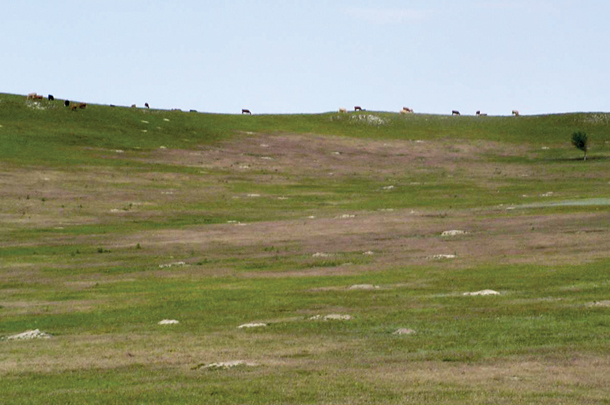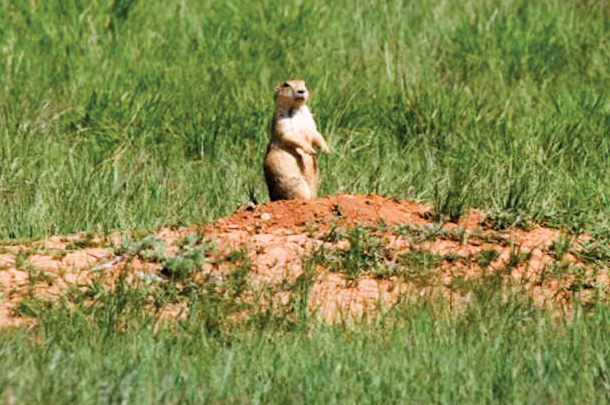South Dakota State University range science professor Pat Johnson, based at the SDSU West River Ag Center in Rapid City, South Dakota, has been studying forage loss due to prairie dogs.
“What we’ve found is that, in general, cattle access or remove about half as much forage on a prairie dog town as they would if the town was not there,” Johnson says.
In her research, she says they were careful to look at forage growing on the same type of soil to make sure their measurements were from equal ground.
Oral, South Dakota, rancher Carl Sanders runs a cow-calf operation in the most southwestern county in the state. Over the years, he has dealt with different levels of prairie dogs in his pastures.

Sanders and his neighbor, who has a prairie dog town on land adjacent to Sanders’, have kept up on their management of the pest.
“Some don’t want to poison. Poison is the most effective way, but it takes time. Guys, they’ll do it once every couple years and wonder why they’re not gaining any ground,” Sanders says. “It’s a several-times-a-year deal.”
The South Dakota Department of Agriculture manufactures bait for rodent control. According to the department’s website, their 2 percent zinc phosphide bait is labeled only for prairie dog control.
The EPA lists it as a restricted-use pesticide. They also produce a gas cartridge to treat small infestations and clean up operations following bait treatment in larger prairie dog infestations.
In addition to poisoning prairie dogs, landowners can also hunt prairie dogs. The South Dakota Game, Fish & Parks Department has an open year-round season except in the Conata Basin and some areas of the Buffalo Gap National Grasslands. There is no limit and no restriction on caliber of rifle.
Sanders has seen prairie dog hunting but says it is not a very effective way to keep prairie dog towns at bay.
“It’s pretty entertaining, but it’s not a very effective means of control. Some of those guys that shoot from 300 or 400 yards away, they can do quite a bit of cleanup. It helps,” Sanders says.
Besides poisoning or hunting prairie dogs, producers can help manage their pastures if they have a prairie dog town in them. Since prairie dogs take away half of the available forage, Johnson says producers should look at their stocking rate.
“One of the key things that producers can do to limit prairie dog expansion would be being careful with stocking rates. Graze somewhat conservatively. Don’t overgraze those pastures or the ones near them,” Johnson says.
Doing these things will not guarantee prairie dogs will not move in, but it will help slow the expansion of a prairie dog town since prairie dogs like short vegetation.

Prairie dogs protect themselves by looking for predators like coyotes, foxes, hawks, eagles and badgers. If the vegetation is tall, they cannot see a predator coming. In overgrazed pastures or in years of drought, prairie dog towns can expand quickly.
The South Dakota Game, Fish & Parks Department surveys land every few years to get a count on prairie dog-inhabited acres. The last survey was done in 2012 and showed more than 500,000 acres with prairie dogs covering counties along and west of the Missouri River.
In Colorado, the black-tailed prairie dog, Gunnison prairie dog and white-tailed prairie dog burrow their towns. The endangered black-footed ferret also makes its home around prairie dogs.
Since the black-footed ferret eats prairie dogs, and they are endangered, producers wishing to poison Gunnison and white-tailed prairie dogs need to have a survey conducted by a biologist trained in the ferret survey technique, according to a Colorado State University Extension fact sheet.
Colorado landowners who want to poison prairie dogs on their property can use grain baits and fumigants. Landowners need to have a private pesticide applicator license from the state’s department of agriculture before using the poison.
Colorado landowners should contact the Colorado Department of Agriculture with questions about what pesticides they can use legally and when it can be used.
According to Brenda Sievers, plant industry program manager in the South Dakota Department of Agriculture’s Division of Agricultural Services, producers can file a complaint with the state or county weed and pest board if prairie dogs are encroaching on their land.
However, four conditions must be met before enforcement can be done on a neighbor’s property.
Those conditions include: Plague must be reported in any prairie dog colony east of the Rocky Mountains; the state Game, Fish and Parks Department needs to determine the population level of prairie dogs is above 145,000 acres; prairie dogs are colonized on land where prairie dogs are unwanted by the owner of the impacted land; and the land adjacent to the impacted owner’s land does not have a maintained 1-mile buffer zone on which prairie dog control is applied.
Sievers says last year they had one complaint on the state level. County weed supervisors received more complaints.
Sanders says prairie dogs are a nuisance, but since he has been keeping up on control, they are staying away.
“I keep after them pretty steady; I don’t have a lot,” Sanders says. “They have their place, but they need to be controlled.” ![]()
Wendy Sweeter is a freelance writer based in South Dakota.
PHOTO 1 & 2: Prairie dog towns can cause a reduction of forage production in pastures.
PHOTO 3: A 2012 survey showed more than 500,000 acres in South Dakota had prairie dogs. Photos provided by Pat Johnson - South Dakota State University.







